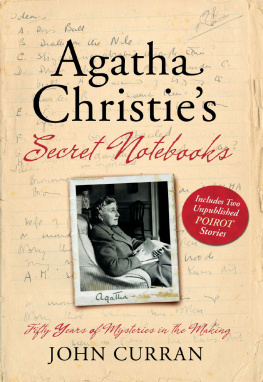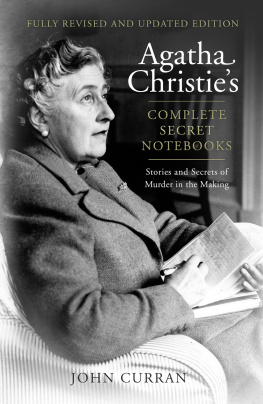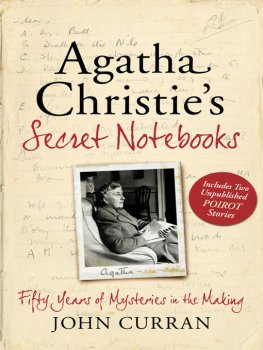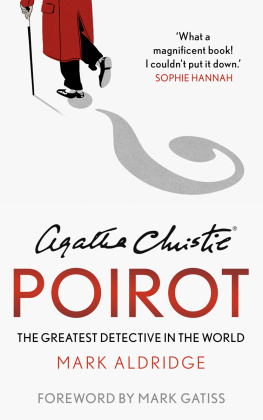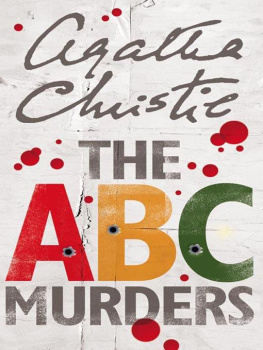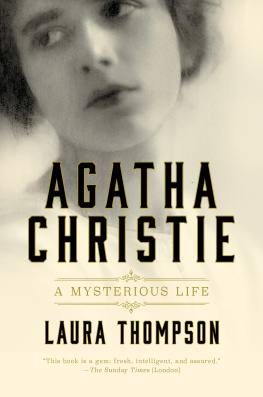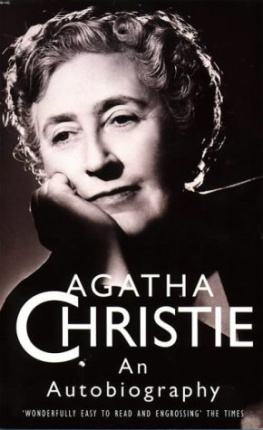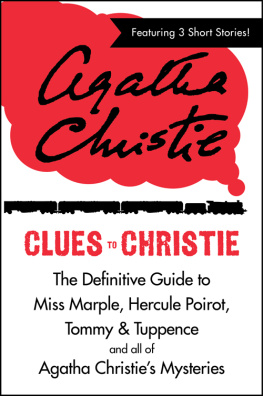For
Joseph, Conor,
Francis, Oisin and Lorcan
This book has benefited greatly from the encouragement and assistance of many people whose names do not appear on the title page.
First and foremost, my thanks go to Mathew Prichard and his wife Lucy. The very existence of this book is due to Mathews generosity. He unhesitatingly agreed to my writing about the Notebooks when I first approached him. And he not only granted me complete and unfettered access to all of his grandmothers papers but he and Lucy also extended me limitless hospitality on the many occasions when I studied them.
David Brawn, HarperCollins, for his faith in the project and Steve Gove for his eagle-eyed editing.
My brother Brendan read an early draft and his positive words gave much encouragement; and with his wife, Virginia, he provided me with a home-from-home (but with superior technical backup!).
My friend and fellow Christie devotee, Tony Medawar, made many helpful suggestions as well as sharing his research with me.
Felicity Windmill, HarperCollins Archivist; Dr Christine Faunch and her staff in Exeter University Library; Tamsen Harward and Jemma Jones at Agatha Christie Ltd.
David Headley of Goldsboro Books for his invaluable help and advice.
My many colleagues and friends in Dublin City Council for their support, especially Michael Sands, Press Officer and Jane Alger, Divisional Librarian, Readers Services.
And, for various reasons, my thanks also to Eurion Brown, Pete Coleman, Julius Green, John Perry, John Ryan, John Timon, Andy Trott and Nigel Wollen.
I have tidied up Agatha Christies notes as little as possible. Every page of every Notebook is littered with dashes, brackets and question marks; complete sentences are the exception rather than the rule. I have removed some capital letters, brackets and dashes, solely in the interests of legibility. In some cases I have amended a paragraph of words, broken only by dashes, into separate sentences. All remaining question marks, underlining, crossing-out, exclamation marks and dashes, as well as some grammatical errors, are as they appear in the Notebooks. If I have omitted text from within extracts I indicate this by the use of dots.
Spellings have not been corrected but marked as [sic].
Square brackets are used for editorial clarification or remarks.
Dates of publication refer to the UK edition. They have been taken, for the most part, from contemporary catalogues in Collins archives. Traditionally, Crime Club titles were published on the first Monday of the month and in the few instances where actual dates were not available, I have used this guideline.
I have reinstated the title Ten Little Niggers , rather than the more politically correct And Then There Were None , throughout. This accurately reflects both the Notebooks and the book as Agatha Christie first saw it in November 1939.
At the beginning of each chapter I have included a list of titles whose solutions are revealed within. It proved impossible to discuss a title intelligently or to compare it to the Notebooks unless I disclosed some endings, and in many cases the notes mention the vital name or plot device anyway. Christies creative ruthlessness in deciding her killer is a vital part of her genius and to try circumventing this with ambiguous verbal gymnastics cannot do her justice.
In deciding which titles to include and which to omit, I intentionally avoided an alphabetical or a chronological listing. The former is meaningless in the context of this book and the latter resulted in all the classic titles appearing together in the middle years of Christies career. I decided on a thematic arrangement, thereby incorporating variety and simultaneously illustrating Christies exploitation of a motif. The grouping of titles within categories is somewhat arbitrary. Some titles might fit under a few headings, e.g. A Caribbean Mystery could appear in either A Holiday for Murder or Murder Abroad Five Little Pigs could fit neatly into The Nursery Rhyme Murders and Murder in Retrospect. I selected and arranged them with an eye to variety and balance.
Relatively few short stories have detailed notes. I have chosen those with sufficient notes to make their inclusion worthwhile.
It is not possible in a book of this size to mention every title and if your favourite is missing I apologise; I hope to remedy this situation in a subsequent and expanded edition.
It is important for readers to note that the Notebooks are not available for viewing. It is hoped in a few years to be able to grant limited access to them but at present this is not possible.
Quite a few years ago, my first wife, Angela, and I made a trip to Calgary in western Canada to see a world premiere of a very early Agatha Christie play called Chimneys . At the first reception we met a quiet, bespectacled Irishman called John Curran. He took with his customary good humour my opening gambit that he must be mad to travel from Dublin to Calgary to see an Agatha Christie play and we have been friends ever since.
After my parents died at Greenway in Devon, which has recently been taken over by the National Trust (and has just been reopened), John was a frequent visitor. Most people who visit Greenway are transfixed by the gardens and the walks by the river. Not John. He spent all his time in the fax room, a room on the first floor about ten feet by four in which the Agatha Christie archive was kept. He had to be prised out for meals, sometimes spending 12 hours a day immersed in the history of Agatha Christies work.
It was here that Johns love affair with Agatha Christies Notebooks blossomed, and neither he nor I could believe our (and your) good fortune when HarperCollins agreed to publish Johns book about them. I think you will find that his fascination and enthusiasm for them emerge very clearly and, as a bonus, he has included two very rare Agatha Christie short stories.
I never cease to be astounded that over 30 years since she died, interest in every aspect of Agatha Christies life and work is still at fever pitch. To Johns credit, he has always concentrated on her work, leaving to others more morbid fascination about the person behind the books, and here is a book which deals with the very kernel, the raw material of all this great work. It is highly personal and certainly a piece of literary history. John has produced a treat for us allI hope you enjoy it.
MATHEW PRICHARD
Shadows in SunlightInterlude at
Greenway, Summer 1954
As she watches the river below, a pleasure steamer chugs towards Dartmouth, sun glinting on the water in its wake. The laughter of the holidaymakers on board reaches her vantage point in the Battery, and the dog at her feet raises his head peering inquisitively towards the river. A drowsy bee is the only other sound that disturbs her peace. Elsewhere in this haven the gardener, Frank, is busy preparing for the flower show and Mathew is following the treasure hunt she set for him, but here in this semicircular battlement at the edge of the garden overlooking the river she has peace. And a temporary solitude to think about her next project after a wonderful period of leisureeating the glorious produce of the garden and swimming in the sea and picnicking on the nearby moors and lazing on the lawn and enjoying the company of her family and friends.
She knows that if she lets her mind wander inspiration will come; after all, for over 35 years her imagination has never let her down and there is no reason to suppose that in this tranquil setting it will fail her. She gazes vaguely around. Just visible to her left is the roof of the Boathouse, and behind and to the right the garden continues its upward climb towards the imposing Georgian house. She can now hear occasional rustles in the undergrowth as Mathew follows her trail of clues.

